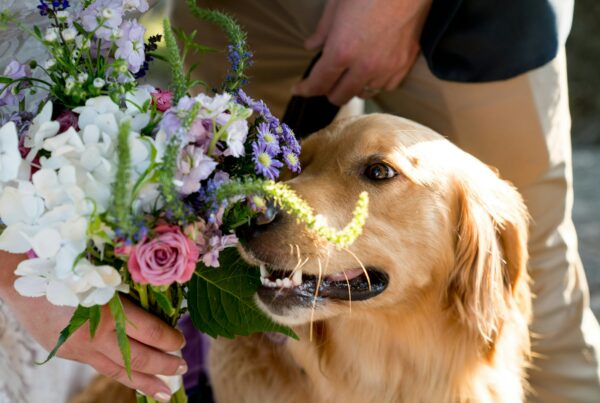(MNN.com) — I admire people who can complete a hectic day at the office, then hit the gym to exercise for an hour. For me, the perfect end to a busy day involves channel surfing with a cup of salted caramel ice cream and cuddle time with my dog Lulu. Alas, every vice has its price. No matter how many fun and fashionable colors I find, super stretchy yoga pants are not acceptable work attire.
Also, I know from experience that a tired dog truly is a well-behaved dog. Neglecting those twice-daily walks has led to mischief in my home. Out of sheer boredom, Lulu chooses naughty activities that include — but are not limited to — chewing shoes, shredding dog beds and redecorating my bedroom with toilet paper confetti.
“When you have a bored dog, that’s when you start having trouble; they get destructive, especially in a bully breed,” warns Craig Hughes, owner of Petmeisters Pet Sitting service in Atlanta. “It’s good to keep that energy burned.”
A tired dog also tends to be a bit healthier. Unfortunately, pets have packed on the pounds right along with their human companions. More than half of the cats and dogs in this country are overweight or obese, according to a study by the Association for Pet Obesity Prevention (APOP). That extra girth carries an increased risk for diabetes, heart disease and several other pricey health issues no longer reserved for humans.
MNN: What should I feed my dog?
Since the Centers for Disease Control and Prevention estimates that about 33.8 percent of adults and 17 percent of our kids and adolescents are obese, maybe the New Year is a perfect time to drop the remote and master the lost art of walking your dog.
Put some pep in your step
Whether you take a short circle around the block or trek through the woods, focus on maintaining a good, steady pace. I quickly worked up a healthy glow trying to keep up with Hughes and his pit bull, Pearl, during their afternoon walk. Huffing and puffing (that would be me), we cruised the neighborhood to the tune of Pearl’s jingling collar.
“If you are really moving and have pep to your step — even for 10 minutes — it makes a big difference,” Hughes says. “Sometimes a good, solid 10-minute walk might be better than 20 minutes of playing ball in the backyard.”
Most dogs would spend their days playing fetch or tugging a rope toy, but Hughes says that dogs need physical and mental stimulation to avoid boredom or unwanted behavior. Consistent walks help dogs mentally reboot.
MNN: How can I keep my pooch for humping other dogs?
“When we started working with Pearl, she was all over the place, trying to go here and there,” Hughes says. The pooch had been rescued from a backyard breeder and spent most of her life tethered outside. “She would see another dog and have total meltdowns trying to play, and then would become leash-aggressive. She’s come a long way for sure.”
During our walk, Pearl barely broke her stride as she passed chained dogs and four-legged neighbors barking feverishly in their backyards.
Even if your pooch has been around the block a few times, Hughes says you can teach old dogs new tricks. Start each trek by letting your pooch relieve herself. Afterward, she should walk at your side in the heel position without pulling or giving in to distractions. Maintaining a steady pace keeps the dog focused on your walk, and helps you remain in control when the unexpected occurs.
“Otherwise,” Hughes says, “it’s harder to control if a dog runs loose or a child runs out.”
Invest in user-friendly gear
To reinforce consistency, Hughes uses his clients’ leashes during typical dog walks. At home, he prefers leashes with dual handles. The short handle offers more control when a dog needs to heel and focus during walks, while the longer handle gives them room to roam on the way home. He also recommends martingale dog collars, which are more difficult for dogs to shed if they get distracted or scared and try to flee during a walk. Any time your pet goes outside, she should wear ID tags with up-to-date contact info.
MNN: How pet owners should prepare for an emergency
Focus on the walk
Always watch for potential distractions that may trigger your dog to react negatively. Hughes prefers to avoid sidewalks and hit the asphalt. That tip comes in handy on trash days; otherwise my Lulu would happily romp from house to house snorting garbage cans.
“With the sidewalk you are in the trenches, that’s where all the smells are, and the dog has a harder time focusing,” Hughes says. “[Walking on asphalt] creates a buffer for situations where there might be a loose dog or people hanging out. Also, on the sidewalk certain situations could escalate much quicker.”
Determine the safest option for you and your pet and be on the lookout for potential distractions. That means you will have to abandon phone calls, iTunes playlists or Pandora Quick Mixes and enjoy Mother Nature, just like your pooch.
Know your pet’s limitations
At 4 years old, Pearl requires frequent walks to burn energy, while one of Hughes’ older dogs suffers from arthritis and can handle only short treks. Consider your dog’s age, weight and health conditions before establishing a walking routine. When in doubt, consult your veterinarian before engaging in any strenuous exercise. The Association for Pet Obesity Prevention lists the ideal weight range for various breeds. An adult Labrador should weigh between 65 to 80 pounds. For overweight pets, the association recommends a walking regimen that begins with a brisk, 10-minute walk, followed by 20 minutes at a casual pace. Allow your pooch to stop and smell the roses — or the trash bins — during that second leg.
“The key is just knowing your dog and reading what they are telling you,” Hughes says. “Gauge their temperament afterward: How calm are they?”
MNN: How to train your dog to behave around houseguests
I know that the walk has done its job when Lulu steps inside the house, takes a few gulps of water from her bowl and then retires to the nearest dog bed — without chewing it.
“Watch your older dogs because sometimes you can over-walk them,” Hughes warns. “If I walk my Lab as long as I walk Pearl, she will be hurting, even though she will walk as long as I take her.”
Extreme dogs require extreme pet gear
If you plan to take your trek way off-road, your pet may require extra gear. Patrick Kruse created collapsible dog bowls after his pooch refused to drink water from a plastic baggie during their hike. That product launched Ruff Wear nearly two decades ago. Now the company specializes in gear for active dogs such as backpacks, boots, coats and harnesses. Four-legged ambassadors, such as the Mount Bachelor Avalanche Rescue Dog Team, get free gear in exchange for valuable product feedback for the Oregon-based company.
“We try to make sure the gear is suitable for dogs in all conditions,” says Susan Strible, marketing director for Ruff Wear. They have to be comfortable while keeping dogs dry and protecting them through the elements. Think of what we walk on with our shoes, especially sidewalks in winter with salt.”
Strible says the company’s all-terrain Bark’n Boots ($64.95) are top sellers. Adjustable straps provide a snug fit while pooches tackle hiking trails or salt-lined sidewalks. On its blog for active dogs, Ruff Wear offers tips to address the “boot dance,” that awkward, paw-shaking adjustment period when dogs first try on the new shoes.
“Once you get the boots on your dog, distract them with a favorite toy or treat — or go on to the activity,” she says. “The sooner dogs are distracted on other things, the sooner they avoid focusing on wearing shoes.”
MNN: How to find the right doggie daycare
In addition to all-terrain boots, Strible says that Ruff Wear fans typically stock up on insulated jackets and overcoats to help dogs handle the elements. If you want your dog to do more than a standard walk around the block, consider gear that will keep them comfortable without limiting mobility.
“Start with the climate,” she says. “In some places it’s really warm and the dog may need a cooling jacket to keep the sun off its back. Then think about the terrain. There’s ice and snow, and it’s rocky in Oregon, boots are important so the dog is not injured in middle of nowhere.”
Keep it interesting
Everyone needs a little change of pace, including your pets. Once Hughes establishes a walking routine, he likes to keep pooches mentally stimulated by changing the route. Taking the road less traveled often benefits pets — and their people.
“You have to diversify,” he says. “You work all day, then you come home and sit on your couch. Then back to work to sit at a desk. You want more; you want to feel the air; you want to feel the grass between your toes.”


